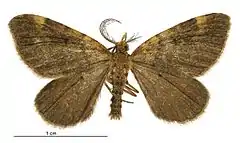Asaphodes chlorocapna
Asaphodes chlorocapna is a species of moth in the family Geometridae. This species is endemic to New Zealand. It is classified as "At Risk, Relict'" by the Department of Conservation.
| Asaphodes chlorocapna | |
|---|---|
 | |
| Male | |
| Scientific classification | |
| Kingdom: | |
| Phylum: | |
| Subphylum: | |
| Class: | |
| Order: | |
| Family: | |
| Genus: | |
| Species: | A. chlorocapna |
| Binomial name | |
| Asaphodes chlorocapna | |
| Synonyms[2] | |
| |
Taxonomy
This species was first described by Edward Meyrick in 1925 as Xanthorhoe chlorocapna using a specimen collected by Stewart Lindsay at Mangere Island, in the Chatham Islands.[2][3] George Hudson discussed and illustrated the species in 1928 using the name Xanthorhoe chlorocapna.[4] In 1987 R. C. Craw placed this species within the genus Asaphodes.[5] The holotype specimen is held at the Canterbury Museum.[2]
Description
Meyrick described the species as follows:
♂︎ 24-26 mm. Head, palpi, thorax pale greyish-ochreous irrorated blackish. Antennal pectinations ten ; forewings with termen slightly bowed, rather oblique ; light smoky-grey suffusedly irrorated dark fuscous ; costal area from base to 4⁄5 rather broadly suffused pale greyish-ochreous, with groups of two antemedian, and three postmedian dark fuscous shades crossing it, but becoming obsolete downwards ; discal spot small, transverse, dark fuscous ; cilia whitish, basal half dark grey. Hind wings dark grey ; cilia whitish, basal third grey.[3]
Distribution
This species is endemic to New Zealand.[1][6] It can only be found in the Chatham Islands where it can be found on Mangere Island, Pitt Island and Rangatira Island.[7]
Biology and life cycle
Adult moths are on the wing in January.[4]
Host plants and habitat
The larvae of this moth consume the fallen leaves of Muehlenbeckia species.[7]
Conservation status
This moth is classified under the New Zealand Threat Classification system as being "At Risk, Relict".[8]
References
| Wikimedia Commons has media related to Asaphodes chlorocapna. |
| Wikispecies has information related to Asaphodes chlorocapna. |
- "Asaphodes chlorocapna (Meyrick, 1925)". www.nzor.org.nz. Landcare Research New Zealand Ltd. Retrieved 15 May 2018.
- Dugdale, J. S. (1988). "Lepidoptera - annotated catalogue, and keys to family-group taxa" (PDF). Fauna of New Zealand. 14: 172. Retrieved 15 May 2018.
- Meyrick, Edward (1925). "Lepidoptera of the Chatham Islands". Records of the Canterbury Museum. 2 (5): 269–275.
- Hudson, G. V. (1928). The Butterflies and Moths of New Zealand. Wellington: Ferguson & Osborn Ltd. p. 114.
- Craw, R. C. (2 February 2012). "Revision of the genus Helastia sensu stricto with description of a new genus (Lepidoptera: Geometridae: Larentiinae)". New Zealand Journal of Zoology. 14 (2): 269–293. doi:10.1080/03014223.1987.10422997.
- Gordon, Dennis P., ed. (2010). New Zealand inventory of biodiversity. Volume two. Kingdom animalia : chaetognatha, ecdysozoa, ichnofossils. Vol. 2. Christchurch, N.Z.: Canterbury University Press. p. 459. ISBN 9781877257933. OCLC 973607714.
- Patrick, Brian; Dugdale, John S. (2000). Conservation status of the New Zealand lepidoptera (PDF). Wellington, N.Z.: Department of Conservation, New Zealand. p. 19. ISBN 978-0478218671. OCLC 154670803.
- Hoare, R.J.B.; Dugdale, J.S.; Edwards, E.D.; Gibbs, G.W.; Patrick, B.H.; Hitchmough, R.A.; Rolfe, J.R. (2017). Conservation status of New Zealand butterflies and moths (Lepidoptera), 2015 (PDF). Wellington, New Zealand: New Zealand Department of Conservation. p. 7. ISBN 9781988514383.